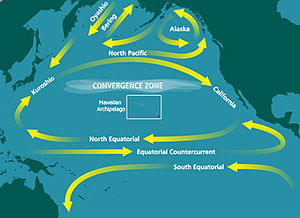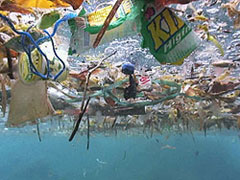
Plastic Pollution Adds Up: Great Pacific Garbage Patch
 Happy Shark Week! The Discovery Channel’s yearly celebration of sharks began last night. Last year we took a week to embrace ocean themes, including the truth of Shark Finning. We’ll continue the tradition and explore more aquatic green-isms this week…
Happy Shark Week! The Discovery Channel’s yearly celebration of sharks began last night. Last year we took a week to embrace ocean themes, including the truth of Shark Finning. We’ll continue the tradition and explore more aquatic green-isms this week…
Nothing is more pristine than taking in nature, sitting on the beach and looking at the ocean… even if it’s at the lame Jersey Shore (compared to Hawaii...)
After spending the past week at the Jersey Shore with my family, I was highly disappointed to not be allowed in the Ocean for 2 days due to trash and a “high bacteria count” of the water. If the water wasn’t safe for me to take a swim, what’s going on with the marine life in the rest of the oceans?
Did you know that one of the largest ‘landfills’ on Earth lies in the middle of the Pacific Ocean?
 The “Great Pacific Garbage Patch” (or “debris”) is stationed in the North Pacific gyre due to ocean currents (North Pacific, California, North Equatorial & Kuroshio Currents) essentially swirling in a clockwise direction. Man-made trash with high concentrators of plastic (bags & bottles), chemical sludge & debris make up a highly-concentrated area that’s been estimated to twice the size of Texas and weighing 3 million tons. Marine life such as seabirds, mammals, turtles & other marine life ingest & get entangled by plastic debris all over the ocean. What’s worse than 1 animal dying from ingesting this plastic (many experts think animals like turtles mistake the plastic bags for jellyfish), is the plastic doesn’t break down and when the animal decomposes, it affects another animal as a victim, working its way up the food chain. At least 267 different species have suffered from such fate. It’s important to keep in mind that plastic doesn’t end up ONLY in these gyres – it’s all over the ocean.
The “Great Pacific Garbage Patch” (or “debris”) is stationed in the North Pacific gyre due to ocean currents (North Pacific, California, North Equatorial & Kuroshio Currents) essentially swirling in a clockwise direction. Man-made trash with high concentrators of plastic (bags & bottles), chemical sludge & debris make up a highly-concentrated area that’s been estimated to twice the size of Texas and weighing 3 million tons. Marine life such as seabirds, mammals, turtles & other marine life ingest & get entangled by plastic debris all over the ocean. What’s worse than 1 animal dying from ingesting this plastic (many experts think animals like turtles mistake the plastic bags for jellyfish), is the plastic doesn’t break down and when the animal decomposes, it affects another animal as a victim, working its way up the food chain. At least 267 different species have suffered from such fate. It’s important to keep in mind that plastic doesn’t end up ONLY in these gyres – it’s all over the ocean.
It’s a horrible image, but why should we care about our litter on the east coast affecting the Pacific?
Captain Charles Moore estimates there’s 6 pounds of plastic for every pound of plankton in this Pacific area. On the International Coastal Cleanup Day in 2009 with Worldwide participants, 1,126,774 of the items collected were plastic bags. And our beloved Atlantic Ocean has a track record of the same pollution, often plastic waste.
Essentially, the Atlantic Ocean (and those same beaches you visit in the summer… Jersey, Maryland, etc) are all down stream of our waste. All of our actions (even in Philly) can eventually end up in the ocean. And if you enjoy a delicious jersey crab or fresh seafood… guess who’s ingesting that plastic eventually resurfacing at the top of the food chain.
How can you help? Try cutting the amount of ‘waste’ you produce. For example, reducing single-use plastic products in favor of reusable ones help keep trash out of our systems and oceans. Plastic bags, bottles and other disposable items continue to pollute our waters, and could build more of these patches (even on the Atlantic Ocean). Let’s think harder about what we do right now… so future generations can enjoy going into the Jersey Shore waters as well.








